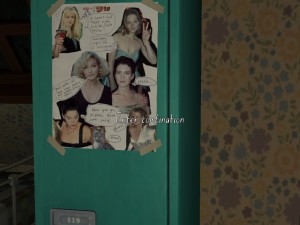Gone Home is an interesting title from the Indie market, with polarizing opinions about its design and definition as a game. Whenever someone asks the “is this a game or not,” argument, Gone Home is usually cited somewhere.
Another interesting detail is how Gone Home has inspired an almost “narrative adventure” subgenre; where players can explore a detailed environment to learn a story, as opposed to the straight up linearity of most adventure games.
Since then, we have seen developers try to emulate the success with other games built around storytelling rather than gameplay; The Vanishing of Ethan Carter and Layers of Fear are two examples. However, these games have not been able to achieve the same critical praise that Gone Home did, and gives us something to talk about today.
Gone Home might appear to be a simple title, but like its story, there is depth under the surface that made it into the success that it is.
Taking a Tour:
One of the more impressive parts of Gone Home is the pacing of the game, and how it’s actually defined by the player. Other narrative heavy games like to push the player in certain directions to keep the plot going and to make sure that the player doesn’t get tired of the game, but not Gone Home.
There is a path for the player to follow from beginning to end of Gone Home, but the designers don’t force you to follow it. The gamespace was laid out organically in the form of exploring the multi-floor household. The player is free to look around the rooms that are available to their heart’s content, and more importantly, areas of the household never became locked or inaccessible to the player.
The open layout of the game also had an impact on the challenges of Gone Home. Instead of having puzzles that either didn’t make sense or take the player out of the environment, the puzzles to the game were also presented organically to the environment. A locked door to another side of the house didn’t require chocolate, rubber bands and a pinky ring; instead, you just needed to find the key.
Searching the environment also provided clues as well as lore to the game’s setting. Being able to explore and figure out the state of household and the family was another high point for the game’s storytelling, but we’ll come back to that in a minute.
Being inside a house as opposed to fantasy or unrealistic settings also gave Gone Home a different feel compared to its peers.
A house is obviously a finite space and this allows someone to have their own sense of accomplishment with exploring each room. You can check off each room and gave the exploration a sense of completion as well.
For our next point, how Gone Home managed to tell a great story without really saying a word.
Passive Observer:
Storytelling in video games is just as varied and with different implementations as gameplay is. Gone Home’s basic plot doesn’t reveal much to the player: They arrive home late at night after being abroad to find their family home seemingly abandoned. The player is given no further information about the state of the household, with the only exception being that their family consists of a mom, dad and sister.
At the start, Gone Home’s story could have gone any number of ways: The game could have been a comedy of messing with your family’s house, a horror game of finding your family missing or worse, or emotional as the developers wanted it. Having that freedom of plot is something very unique with video game storytelling. Most of the time, the player has a basic idea of what the game is before they start playing, or the game opens up with some kind of narration that fills in the details.
With Gone Home, the player starts at practically zero and is left to wander the house searching for both their family and information about the main character’s life.
Credit needs to be given the designers for how they set up the house both from an aesthetics and design point of view. The game takes place in the 90’s with the house’s decoration and architecture feeling like a time capsule. As the player wanders around, they can get an idea of the lives of their family from how everything is laid out and by finding lore. While the game pushes you to discover more about your sister’s life, you can also find details about your mom and dad.

While Layers of Fear tried to emulate the exploration element of Gone Home, the linearity of the design got in the way of player freedom
One debatable choice was how “gamey” the information was set up and how the early areas of the house just so happened to have the oldest information about the family, while the harder to reach areas had information more current.
I’m sure that the developers went back and forth in this regard and it would have been very easy to have information of various periods all over, but that would have made it harder to follow things.
Another great storytelling point was how each family member essentially had their own story in the game. Once again, this made Gone Home’s story a lot more malleable compared to other games; allowing the designers to change the tone depending on the current plot line you’re following. For the dad’s story as an example, it could be funny as you’re reading his plots and story ideas for his novel, or sad as you find the rejection letters.
Then there is the sister’s plot, which took the game’s story and the player’s perspective in an entirely different direction.
SPOILER WARNING: The next section talks specifically about a major story point in Gone Home; read on at your own risk.
The main storyline in Gone Home and the one that the game dedicates the most time to exploring is the sister’s. As you explore her room and find her diary logs around the house, you learn about her growing interest in a girl and being conflicted by those feelings. The sister’s logs run the gambit of emotions depending on the event and the time period.
Gone Home taking place in the 90’s also adds another layer to this story, as being LGBT was not something openly celebrated, but hidden for a lot of people at the risk of being demonized by the majority who didn’t understand.
As the player learned more about the sister, the game sets the player up for a dark ending; with a surprise hidden in the attic after walking down an ominous hall. Going up to the attic is another mood altering experience and gives the game a sense of horror as the player didn’t know what to expect.
Given how Gone Home was set up, the ending could have gone in a lot of ways, but things worked out as the sister leaves one last note telling the player that she is leaving with her lover and that everything is fine.
Coming Home:
Gone Home was an impressive title and is an example of a narrative adventure that proved to be a success. While it may not have the gameplay of traditional adventure games or the multiple endings of narrative-focused titles, it’s a great example of a game that is greater than the sum of its parts.
For frequent visitors to Game-Wisdom, you know that I’m a mechanics person; preferring mechanics and design over storytelling. With that said, Gone Home was one of the few narrative titles to pull me in, and that says a lot about a game’s quality. Gone Home also stands as another shining example of the quality and imaginative concepts that we normally only see from the Indie crowd.



